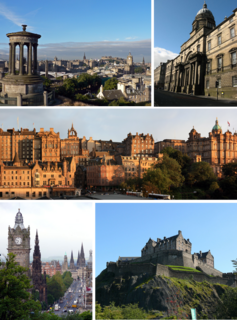Charles McIntosh (April 4, 1892 [1] – 1970 [2] ) was a Scottish-born farmer and political figure in Saskatchewan. He represented Kinistino in the Legislative Assembly of Saskatchewan from 1925 to 1933 as a Liberal.

Scotland is a country that is part of the United Kingdom. Sharing a border with England to the southeast, Scotland is otherwise surrounded by the Atlantic Ocean to the north and west, by the North Sea to the northeast and by the Irish Sea to the south. In addition to the mainland, situated on the northern third of the island of Great Britain, Scotland has over 790 islands, including the Northern Isles and the Hebrides.

Saskatchewan is a prairie and boreal province in western Canada, the only province without a natural border. It has an area of 651,900 square kilometres (251,700 sq mi), nearly 10 percent of which is fresh water, composed mostly of rivers, reservoirs, and the province's 100,000 lakes.
Kinistino was a provincial electoral district for the Legislative Assembly of the province of Saskatchewan, Canada. Located in north-central Saskatchewan, it was centred on the town of Kinistino. This constituency was one of 25 created for the 1st Saskatchewan general election in 1905.
He was born near Edinburgh, the son of John McIntosh and Elizabeth Pratt, came to Canada with his family in 1904, and was educated in Portage la Prairie, Manitoba. McIntosh married Genevieve H. Laidlaw in 1919. He served overseas with the Canadian Expeditionary Force during World War I. [1] In 1932, McIntosh decided to support the coalition government of James Thomas Milton Anderson. Anderson named McIntosh to his cabinet as Minister of Natural Resources on April 29, 1933. However, when McIntosh ran for reelection to the assembly as a government supporter on May 22 that same year, he was defeated by Liberal John Richard Parish Taylor. [3]

Edinburgh is the capital city of Scotland and one of its 32 council areas. Historically part of the county of Midlothian, it is located in Lothian on the Firth of Forth's southern shore.

The Canadian Expeditionary Force (CEF) was the designation of the field force created by Canada for service overseas in the First World War. The force fielded several combat formations on the Western Front in France and Belgium, the largest of which was the Canadian Corps, consisting of four divisions. The Canadian Cavalry Brigade and the Canadian Independent Force, which were independent of the Canadian Corps, also fought on the Western Front. The CEF also had a large reserve and training organization in England, and a recruiting organization in Canada. In the later stages of the European war, particularly after their success at Vimy Ridge and Passchendaele, the Canadian Corps was regarded by friend and foe alike as one of the most effective Allied military formations on the Western Front. In August 1918, the CEF's Canadian Siberian Expeditionary Force travelled to revolution-torn Russia. It reinforced an anti-Bolshevik garrison in Vladivostok during the winter of 1918–19. At this time, another force of Canadian soldiers were placed in Archangel, where they fought against Bolsheviks.

World War I, also known as the First World War or the Great War, was a global war originating in Europe that lasted from 28 July 1914 to 11 November 1918. Contemporaneously described as "the war to end all wars", it led to the mobilisation of more than 70 million military personnel, including 60 million Europeans, making it one of the largest wars in history. It is also one of the deadliest conflicts in history, with an estimated nine million combatants and seven million civilian deaths as a direct result of the war, while resulting genocides and the 1918 influenza pandemic caused another 50 to 100 million deaths worldwide.

